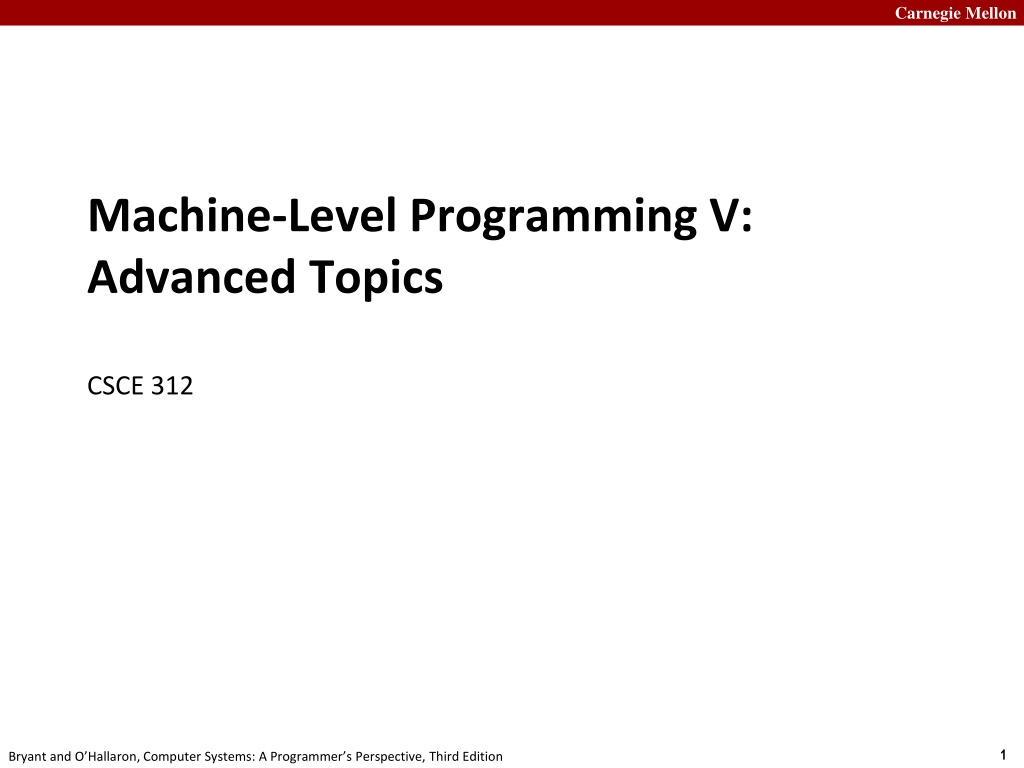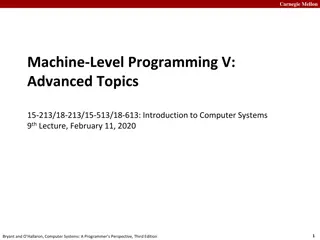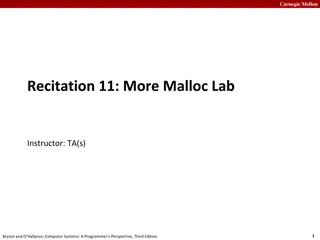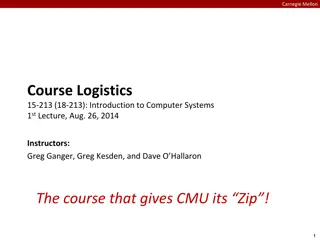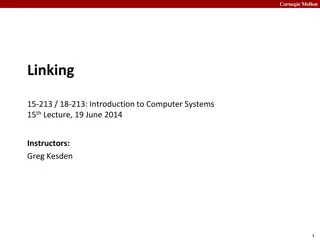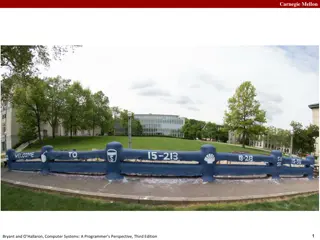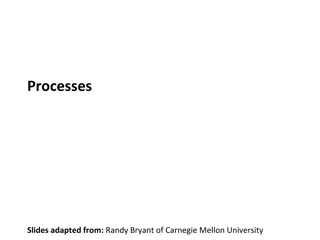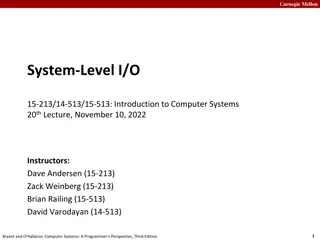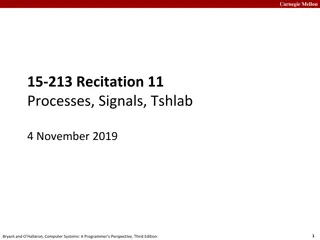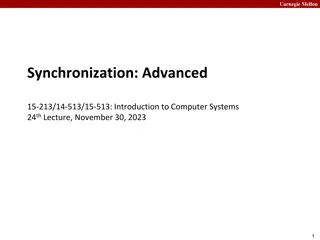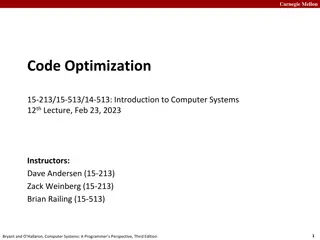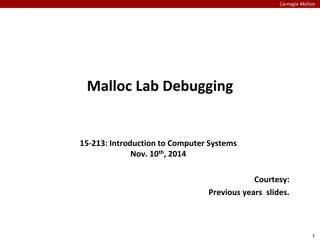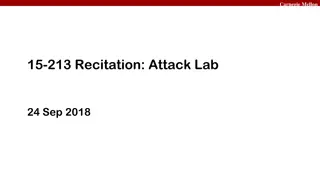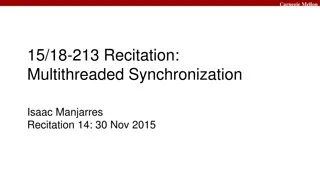Understanding Memory Layout in Computer Systems at Carnegie Mellon
Explore the memory layout in computer systems through the lens of Carnegie Mellon University's advanced topics in machine-level programming. Learn about buffer overflow vulnerability protection, memory allocation examples, x86-64 Linux memory layout, and addressing schemes. Dive into practical examples and diagrams illustrating stack, heap, shared libraries, and more.
Download Presentation

Please find below an Image/Link to download the presentation.
The content on the website is provided AS IS for your information and personal use only. It may not be sold, licensed, or shared on other websites without obtaining consent from the author. Download presentation by click this link. If you encounter any issues during the download, it is possible that the publisher has removed the file from their server.
E N D
Presentation Transcript
Carnegie Mellon Machine-Level Programming V: Advanced Topics CSCE 312 1 Bryant and O Hallaron, Computer Systems: A Programmer s Perspective, Third Edition
Carnegie Mellon Today Memory Layout Buffer Overflow Vulnerability Protection Unions 2 Bryant and O Hallaron, Computer Systems: A Programmer s Perspective, Third Edition
Carnegie Mellon not drawn to scale x86-64 Linux Memory Layout 00007FFFFFFFFFFF Stack Stack Runtime stack (8MB limit) E. g., local variables 8MB Heap Dynamically allocated as needed When call malloc(), calloc(), new() Data Statically allocated data E.g., global vars, static vars, string constants Shared Libraries Text / Shared Libraries Executable machine instructions Read-only Heap Data Text 400000 Hex Address 000000 3 Bryant and O Hallaron, Computer Systems: A Programmer s Perspective, Third Edition
Carnegie Mellon not drawn to scale Memory Allocation Example Stack char big_array[1L<<24]; /* 16 MB */ char huge_array[1L<<31]; /* 2 GB */ int global = 0; int useless() { return 0; } int main () { void *p1, *p2, *p3, *p4; int local = 0; p1 = malloc(1L << 28); /* 256 MB */ p2 = malloc(1L << 8); /* 256 B */ p3 = malloc(1L << 32); /* 4 GB */ p4 = malloc(1L << 8); /* 256 B */ /* Some print statements ... */ } Shared Libraries Heap Data Text Bryant and O Hallaron, Computer Systems: A Programmer s Perspective, Third Edition Where does everything go? 4
Carnegie Mellon not drawn to scale x86-64 Example Addresses 00007F Stack address range ~247 Heap local p1 p3 p4 p2 big_array huge_array main() useless() 0x00007ffe4d3be87c 0x00007f7262a1e010 0x00007f7162a1d010 0x000000008359d120 0x000000008359d010 0x0000000080601060 0x0000000000601060 0x000000000040060c 0x0000000000400590 Heap Data Text 000000 5 Bryant and O Hallaron, Computer Systems: A Programmer s Perspective, Third Edition
Carnegie Mellon Today Memory Layout Buffer Overflow Vulnerability Protection Unions 6 Bryant and O Hallaron, Computer Systems: A Programmer s Perspective, Third Edition
Carnegie Mellon Recall: Memory Referencing Bug Example typedef struct { int a[2]; double d; } struct_t; double fun(int i) { volatile struct_t s; s.d = 3.14; s.a[i] = 1073741824; /* Possibly out of bounds */ return s.d; } fun(0) fun(1) fun(2) fun(3) fun(4) fun(6) 3.14 3.14 3.1399998664856 2.00000061035156 3.14 Segmentation fault Result is system specific 7 Bryant and O Hallaron, Computer Systems: A Programmer s Perspective, Third Edition
Carnegie Mellon Memory Referencing Bug Example fun(0) fun(1) fun(2) fun(3) fun(4) fun(6) typedef struct { int a[2]; double d; } struct_t; 3.14 3.14 3.1399998664856 2.00000061035156 3.14 Segmentation fault Explanation: Critical State 6 ? 5 ? 4 Location accessed by fun(i) d7 ... d4 3 d3 ... d0 2 struct_t a[1] 1 a[0] 0 8 Bryant and O Hallaron, Computer Systems: A Programmer s Perspective, Third Edition
Carnegie Mellon Such problems are a BIG deal Generally called a buffer overflow when exceeding the memory size allocated for an array Why a big deal? It s the #1 technical cause of security vulnerabilities #1 overall cause is social engineering / user ignorance Most common form Unchecked lengths on string inputs Particularly for bounded character arrays on the stack sometimes referred to as stack smashing 9 Bryant and O Hallaron, Computer Systems: A Programmer s Perspective, Third Edition
Carnegie Mellon String Library Code Implementation of Unix function gets() /* Get string from stdin */ char *gets(char *dest) { int c = getchar(); char *p = dest; while (c != EOF && c != '\n') { *p++ = c; c = getchar(); } *p = '\0'; return dest; } No way to specify limit on number of characters to read Similar problems with other library functions strcpy, strcat: Copy strings of arbitrary length scanf, fscanf, sscanf, when given %s conversion specification 10 Bryant and O Hallaron, Computer Systems: A Programmer s Perspective, Third Edition
Carnegie Mellon Vulnerable Buffer Code /* Echo Line */ void echo() { char buf[4]; /* Way too small! */ gets(buf); puts(buf); } btw, how big is big enough? void call_echo() { echo(); } unix>./bufdemo-nsp Type a string:012345678901234567890123 012345678901234567890123 unix>./bufdemo-nsp Type a string:0123456789012345678901234 Segmentation Fault 11 Bryant and O Hallaron, Computer Systems: A Programmer s Perspective, Third Edition
Carnegie Mellon Buffer Overflow Disassembly echo: 00000000004006cf <echo>: 4006cf: 48 83 ec 18 4006d3: 48 89 e7 4006d6: e8 a5 ff ff ff 4006db: 48 89 e7 4006de: e8 3d fe ff ff 4006e3: 48 83 c4 18 4006e7: c3 sub $0x18,%rsp mov %rsp,%rdi callq 400680 <gets> mov %rsp,%rdi callq 400520 <puts@plt> add $0x18,%rsp retq call_echo: 4006e8: 4006ec: b8 00 00 00 00 4006f1: e8 d9 ff ff ff 4006f6: 48 83 c4 08 4006fa: c3 48 83 ec 08 sub $0x8,%rsp mov $0x0,%eax callq 4006cf <echo> add $0x8,%rsp retq 12 Bryant and O Hallaron, Computer Systems: A Programmer s Perspective, Third Edition
Carnegie Mellon Buffer Overflow Stack Before call to gets Stack Frame for call_echo /* Echo Line */ void echo() { char buf[4]; /* Way too small! */ gets(buf); puts(buf); } Return Address (8 bytes) 20 bytes unused [3][2][1][0] buf %rsp echo: subq $24, %rsp movq %rsp, %rdi call gets . . . 13 Bryant and O Hallaron, Computer Systems: A Programmer s Perspective, Third Edition
Carnegie Mellon Buffer Overflow Stack Example Before call to gets void echo() { char buf[4]; gets(buf); . . . } echo: subq $24, %rsp movq %rsp, %rdi call gets . . . Stack Frame for call_echo 00 00 00 00 Return Address (8 bytes) 00 40 06 f6 call_echo: . . . 4006f1: callq 4006cf <echo> 4006f6: add $0x8,%rsp . . . 20 bytes unused [3][2][1][0] buf %rsp 14 Bryant and O Hallaron, Computer Systems: A Programmer s Perspective, Third Edition
Carnegie Mellon Buffer Overflow Stack Example #1 After call to gets void echo() { char buf[4]; gets(buf); . . . } echo: subq $24, %rsp movq %rsp, %rdi call gets . . . Stack Frame for call_echo 00 00 00 00 Return Address (8 bytes) 00 40 06 f6 00 32 31 30 call_echo: 39 38 37 36 . . . 4006f1: callq 4006cf <echo> 4006f6: add $0x8,%rsp . . . 35 34 33 32 20 bytes unused 31 30 39 38 37 36 35 34 33 32 31 30 buf %rsp unix>./bufdemo-nsp Type a string:01234567890123456789012 01234567890123456789012 Overflowed buffer, but did not corrupt state 15 Bryant and O Hallaron, Computer Systems: A Programmer s Perspective, Third Edition
Carnegie Mellon Buffer Overflow Stack Example #2 After call to gets void echo() { char buf[4]; gets(buf); . . . } echo: subq $24, %rsp movq %rsp, %rdi call gets . . . Stack Frame for call_echo 00 00 00 00 00 40 00 34 Return Address (8 bytes) 33 32 31 30 call_echo: 39 38 37 36 . . . 4006f1: callq 4006cf <echo> 4006f6: add $0x8,%rsp . . . 35 34 33 32 20 bytes unused 31 30 39 38 37 36 35 34 33 32 31 30 buf %rsp unix>./bufdemo-nsp Type a string:0123456789012345678901234 Segmentation Fault Overflowed buffer and corrupted return pointer 16 Bryant and O Hallaron, Computer Systems: A Programmer s Perspective, Third Edition
Carnegie Mellon Buffer Overflow Stack Example #3 After call to gets void echo() { char buf[4]; gets(buf); . . . } echo: subq $24, %rsp movq %rsp, %rdi call gets . . . Stack Frame for call_echo 00 00 00 00 00 40 06 00 Return Address (8 bytes) 33 32 31 30 call_echo: 39 38 37 36 . . . 4006f1: callq 4006cf <echo> 4006f6: add $0x8,%rsp . . . 35 34 33 32 20 bytes unused 31 30 39 38 37 36 35 34 33 32 31 30 buf %rsp unix>./bufdemo-nsp Type a string:012345678901234567890123 012345678901234567890123 Overflowed buffer, corrupted return pointer, but program seems to work! 17 Bryant and O Hallaron, Computer Systems: A Programmer s Perspective, Third Edition
Carnegie Mellon Buffer Overflow Stack Example #3 Explained After call to gets Stack Frame for call_echo register_tm_clones: . . . 400600: 400603: 400606: 40060a: 40060d: 400610: 400612: 400613: mov %rsp,%rbp mov %rax,%rdx shr $0x3f,%rdx add %rdx,%rax sar %rax jne 400614 pop %rbp retq 00 00 00 00 00 40 06 00 Return Address (8 bytes) 33 32 31 30 39 38 37 36 35 34 33 32 20 bytes unused 31 30 39 38 37 36 35 34 33 32 31 30 buf %rsp Returns to unrelated code Lots of things happen, without modifying critical state Eventually executes retqback to main 18 Bryant and O Hallaron, Computer Systems: A Programmer s Perspective, Third Edition
Carnegie Mellon Code Injection Attacks Stack after call to gets() void P(){ Q(); ... } Pstack frame return address A B int Q() { char buf[64]; gets(buf); ... return ...; } pad data written by gets() Q stack frame exploit code B Input string contains byte representation of executable code Overwrite return address A with address of buffer B When Q executes ret, will jump to exploit code 19 Bryant and O Hallaron, Computer Systems: A Programmer s Perspective, Third Edition
Carnegie Mellon Exploits Based on Buffer Overflows Buffer overflow bugs can allow remote machines to execute arbitrary code on victim machines Distressingly common in real progams Programmers keep making the same mistakes Recent measures make these attacks much more difficult Examples across the decades Original Internet worm (1988) IM wars (1999) Twilight hack on Wii (2000s) and many, many more You will learn some of the tricks in attacklab Hopefully to convince you to never leave such holes in your programs!! 20 Bryant and O Hallaron, Computer Systems: A Programmer s Perspective, Third Edition
Carnegie Mellon Example: the original Internet worm (1988) Exploited a few vulnerabilities to spread Early versions of the finger server (fingerd) used gets()to read the argument sent by the client: finger droh@cs.cmu.edu Worm attacked fingerd server by sending phony argument: finger exploit-code padding new-return- address exploit code: executed a root shell on the victim machine with a direct TCP connection to the attacker. Once on a machine, scanned for other machines to attack invaded ~6000 computers in hours (10% of the Internet ) see June 1989 article in Comm. of the ACM the young author of the worm was prosecuted and CERT was formed still homed at CMU 21 Bryant and O Hallaron, Computer Systems: A Programmer s Perspective, Third Edition
Carnegie Mellon Example 2: IM War July, 1999 Microsoft launches MSN Messenger (instant messaging system). Messenger clients can access popular AOL Instant Messaging Service (AIM) servers AIM client MSN server MSN client AIM server AIM client 22 Bryant and O Hallaron, Computer Systems: A Programmer s Perspective, Third Edition
Carnegie Mellon IM War (cont.) August 1999 Mysteriously, Messenger clients can no longer access AIM servers Microsoft and AOL begin the IM war: AOL changes server to disallow Messenger clients Microsoft makes changes to clients to defeat AOL changes At least 13 such skirmishes What was really happening? AOL had discovered a buffer overflow bug in their own AIM clients They exploited it to detect and block Microsoft: the exploit code returned a 4-byte signature (the bytes at some location in the AIM client) to server When Microsoft changed code to match signature, AOL changed signature location 23 Bryant and O Hallaron, Computer Systems: A Programmer s Perspective, Third Edition
Carnegie Mellon Date: Wed, 11 Aug 1999 11:30:57 -0700 (PDT) From: Phil Bucking <philbucking@yahoo.com> Subject: AOL exploiting buffer overrun bug in their own software! To: rms@pharlap.com Mr. Smith, I am writing you because I have discovered something that I think you might find interesting because you are an Internet security expert with experience in this area. I have also tried to contact AOL but received no response. I am a developer who has been working on a revolutionary new instant messaging client that should be released later this year. ... It appears that the AIM client has a buffer overrun bug. By itself this might not be the end of the world, as MS surely has had its share. But AOL is now *exploiting their own buffer overrun bug* to help in its efforts to block MS Instant Messenger. .... Since you have significant credibility with the press I hope that you can use this information to help inform people that behind AOL's friendly exterior they are nefariously compromising peoples' security. Sincerely, Phil Bucking Founder, Bucking Consulting philbucking@yahoo.com It was later determined that this email originated from within Microsoft! 24 Bryant and O Hallaron, Computer Systems: A Programmer s Perspective, Third Edition
Carnegie Mellon Aside: Worms and Viruses Worm: A program that Can run by itself Can propagate a fully working version of itself to other computers Virus: Code that Adds itself to other programs Does not run independently Both are (usually) designed to spread among computers and to wreak havoc 25 Bryant and O Hallaron, Computer Systems: A Programmer s Perspective, Third Edition
Carnegie Mellon OK, what to do about buffer overflow attacks Avoid overflow vulnerabilities Employ system-level protections Have compiler use stack canaries Lets talk about each 26 Bryant and O Hallaron, Computer Systems: A Programmer s Perspective, Third Edition
Carnegie Mellon 1. Avoid Overflow Vulnerabilities in Code (!) /* Echo Line */ void echo() { char buf[4]; /* Way too small! */ fgets(buf, 4, stdin); puts(buf); } For example, use library routines that limit string lengths fgets instead of gets strncpy instead of strcpy Don t use scanf with %s conversion specification Use fgets to read the string Or use %nswhere n is a suitable integer 27 Bryant and O Hallaron, Computer Systems: A Programmer s Perspective, Third Edition
Carnegie Mellon 2. System-Level Protections can help Stack base Randomized stack offsets At start of program, allocate random amount of space on stack Shifts stack addresses for entire program Makes it difficult for hacker to predict beginning of inserted code E.g.: 5 executions of memory allocation code local 0x7ffe4d3be87c Random allocation main Application Code B? 0x7fff75a4f9fc 0x7ffeadb7c80c 0x7ffeaea2fdac 0x7ffcd452017c pad Stack repositioned each time program executes exploit code B? 28 Bryant and O Hallaron, Computer Systems: A Programmer s Perspective, Third Edition
Carnegie Mellon 2. System-Level Protections can help Stack after call to gets() Nonexecutable code segments In traditional x86, can mark region of memory as either read-only or writeable Pstack frame B Can execute anything readable X86-64 added explicit execute permission Stack marked as non- executable pad data written by gets() Q stack frame exploit code B Any attempt to execute this code will fail 29 Bryant and O Hallaron, Computer Systems: A Programmer s Perspective, Third Edition
Carnegie Mellon 3. Stack Canaries can help Idea Place special value ( canary ) on stack just beyond buffer Check for corruption before exiting function GCC Implementation -fstack-protector Now the default (disabled earlier) unix>./bufdemo-sp Type a string:0123456 0123456 unix>./bufdemo-sp Type a string:01234567 *** stack smashing detected *** 30 Bryant and O Hallaron, Computer Systems: A Programmer s Perspective, Third Edition
Carnegie Mellon Protected Buffer Disassembly echo: 40072f: 400733: 40073c: 400741: 400743: 400746: 40074b: 40074e: 400753: 400758: 400761: 400763: 400768: 40076c: sub $0x18,%rsp mov %fs:0x28,%rax mov %rax,0x8(%rsp) xor %eax,%eax mov %rsp,%rdi callq 4006e0 <gets> mov %rsp,%rdi callq 400570 <puts@plt> mov 0x8(%rsp),%rax xor %fs:0x28,%rax je 400768 <echo+0x39> callq 400580 <__stack_chk_fail@plt> add $0x18,%rsp retq 31 Bryant and O Hallaron, Computer Systems: A Programmer s Perspective, Third Edition
Carnegie Mellon Setting Up Canary Before call to gets /* Echo Line */ void echo() { char buf[4]; /* Way too small! */ gets(buf); puts(buf); } Stack Frame for call_echo Return Address (8 bytes) 20 bytes unused Canary (8 bytes) [3][2][1][0] buf %rsp echo: . . . movq movq xorl . . . %fs:40, %rax # Get canary %rax, 8(%rsp) # Place on stack %eax, %eax # Erase canary 32 Bryant and O Hallaron, Computer Systems: A Programmer s Perspective, Third Edition
Carnegie Mellon Checking Canary After call to gets /* Echo Line */ void echo() { char buf[4]; /* Way too small! */ gets(buf); puts(buf); } Before call to gets Stack Frame for call_echo Stack Frame for main Return Address (8 bytes) Return Address Saved %ebp Saved %ebx 20 bytes unused Canary Input: 0123456 Canary (8 bytes) [3][2][1][0] 00 36 35 34 33 32 31 30 buf %rsp echo: stack .L6: . . . movq 8(%rsp), %rax # Retrieve from xorq je call %fs:40, %rax # Compare to canary .L6 # If same, OK __stack_chk_fail # FAIL 33 Bryant and O Hallaron, Computer Systems: A Programmer s Perspective, Third Edition
Carnegie Mellon Return-Oriented Programming Attacks Challenge (for hackers) Stack randomization makes it hard to predict buffer location Marking stack nonexecutable makes it hard to insert binary code Alternative Strategy Use existing code E.g., library code from stdlib String together fragments to achieve overall desired outcome Does not overcome stack canaries Construct program from gadgets Sequence of instructions ending in ret Encoded by single byte 0xc3 Code positions fixed from run to run Code is executable 34 Bryant and O Hallaron, Computer Systems: A Programmer s Perspective, Third Edition
Carnegie Mellon Gadget Example #1 long ab_plus_c (long a, long b, long c) { return a*b + c; } 00000000004004d0 <ab_plus_c>: 4004d0: 48 0f af fe imul %rsi,%rdi 4004d4: 48 8d 04 17 lea (%rdi,%rdx,1),%rax 4004d8: c3 retq rax Gadget address = 0x4004d4 rdi + rdx Use tail end of existing functions 35 Bryant and O Hallaron, Computer Systems: A Programmer s Perspective, Third Edition
Carnegie Mellon Gadget Example #2 void setval(unsigned *p) { *p = 3347663060u; } Encodes movq %rax, %rdi <setval>: 4004d9: c7 07 d4 48 89 c7 movl 4004df: c3 retq $0xc78948d4,(%rdi) rdi Gadget address = 0x4004dc rax Repurpose byte codes 36 Bryant and O Hallaron, Computer Systems: A Programmer s Perspective, Third Edition
Carnegie Mellon ROP Execution Stack c3 Gadget n code c3 Gadget 2 code %rsp c3 Gadget 1 code Trigger with ret instruction Will start executing Gadget 1 Final ret in each gadget will start next one 37 Bryant and O Hallaron, Computer Systems: A Programmer s Perspective, Third Edition
Carnegie Mellon Today Memory Layout Buffer Overflow Vulnerability Protection Unions 38 Bryant and O Hallaron, Computer Systems: A Programmer s Perspective, Third Edition
Carnegie Mellon Union Allocation Allocate according to largest element Can only use one field at a time union U1 { char c; int i[2]; double v; } *up; c i[0] i[1] v up+0 up+4 up+8 struct S1 { char c; int i[2]; double v; } *sp; c i[0] i[1] v 3 bytes 4 bytes sp+0 sp+4 sp+8 sp+16 sp+24 39 Bryant and O Hallaron, Computer Systems: A Programmer s Perspective, Third Edition
Carnegie Mellon Using Union to Access Bit Patterns typedef union { float f; unsigned u; } bit_float_t; u f 0 4 float bit2float(unsigned u) { bit_float_t arg; arg.u = u; return arg.f; } unsigned float2bit(float f) { bit_float_t arg; arg.f = f; return arg.u; } Same as (float) u ? Same as (unsigned) f ? 40 Bryant and O Hallaron, Computer Systems: A Programmer s Perspective, Third Edition
Carnegie Mellon Byte Ordering Revisited Idea Short/long/quad words stored in memory as 2/4/8 consecutive bytes Which byte is most (least) significant? Can cause problems when exchanging binary data between machines Big Endian Most significant byte has lowest address Sparc Little Endian Least significant byte has lowest address Intel x86, ARM Android and IOS Bi Endian Can be configured either way ARM 41 Bryant and O Hallaron, Computer Systems: A Programmer s Perspective, Third Edition
Carnegie Mellon Byte Ordering Example union { unsigned char c[8]; unsigned short s[4]; unsigned int i[2]; unsigned long l[1]; } dw; c[0] c[1] c[2] c[3] c[4] c[5] c[6] c[7] 32-bit s[0] s[1] s[2] s[3] i[0] l[0] i[1] c[0] c[1] c[2] c[3] c[4] c[5] c[6] c[7] 64-bit s[0] s[1] s[2] s[3] i[0] i[1] l[0] 42 Bryant and O Hallaron, Computer Systems: A Programmer s Perspective, Third Edition
Carnegie Mellon Byte Ordering Example (Cont). int j; for (j = 0; j < 8; j++) dw.c[j] = 0xf0 + j; printf("Characters 0-7 == [0x%x,0x%x,0x%x,0x%x,0x%x,0x%x,0x%x,0x%x]\n", dw.c[0], dw.c[1], dw.c[2], dw.c[3], dw.c[4], dw.c[5], dw.c[6], dw.c[7]); printf("Shorts 0-3 == [0x%x,0x%x,0x%x,0x%x]\n", dw.s[0], dw.s[1], dw.s[2], dw.s[3]); printf("Ints 0-1 == [0x%x,0x%x]\n", dw.i[0], dw.i[1]); printf("Long 0 == [0x%lx]\n", dw.l[0]); 43 Bryant and O Hallaron, Computer Systems: A Programmer s Perspective, Third Edition
Carnegie Mellon Byte Ordering on IA32 Little Endian f0 c[0] f1 c[1] f2 c[2] f3 c[3] f4 c[4] f5 c[5] f6 f7 c[7] c[6] s[0] s[1] s[2] s[3] i[0] l[0] i[1] LSB MSB MSB LSB Print Output: Characters 0-7 == [0xf0,0xf1,0xf2,0xf3,0xf4,0xf5,0xf6,0xf7] Shorts 0-3 == [0xf1f0,0xf3f2,0xf5f4,0xf7f6] Ints 0-1 == [0xf3f2f1f0,0xf7f6f5f4] Long 0 == [0xf3f2f1f0] 44 Bryant and O Hallaron, Computer Systems: A Programmer s Perspective, Third Edition
Carnegie Mellon Byte Ordering on Sun Big Endian f0 c[0] f1 c[1] f2 c[2] f3 c[3] f4 c[4] f5 c[5] f6 f7 c[7] c[6] s[0] s[1] s[2] s[3] i[0] l[0] i[1] MSB LSB LSB MSB Print Output on Sun: Characters 0-7 == [0xf0,0xf1,0xf2,0xf3,0xf4,0xf5,0xf6,0xf7] Shorts 0-3 == [0xf0f1,0xf2f3,0xf4f5,0xf6f7] Ints 0-1 == [0xf0f1f2f3,0xf4f5f6f7] Long 0 == [0xf0f1f2f3] 45 Bryant and O Hallaron, Computer Systems: A Programmer s Perspective, Third Edition
Carnegie Mellon Byte Ordering on x86-64 Little Endian f0 c[0] f1 c[1] f2 c[2] f3 c[3] f4 c[4] f5 c[5] f6 f7 c[7] c[6] s[0] s[1] s[2] s[3] i[0] i[1] l[0] LSB MSB Print Output on x86-64: Characters 0-7 == [0xf0,0xf1,0xf2,0xf3,0xf4,0xf5,0xf6,0xf7] Shorts 0-3 == [0xf1f0,0xf3f2,0xf5f4,0xf7f6] Ints 0-1 == [0xf3f2f1f0,0xf7f6f5f4] Long 0 == [0xf7f6f5f4f3f2f1f0] 46 Bryant and O Hallaron, Computer Systems: A Programmer s Perspective, Third Edition
Carnegie Mellon Summary of Compound Types in C Arrays Contiguous allocation of memory Aligned to satisfy every element s alignment requirement Pointer to first element No bounds checking Structures Allocate bytes in order declared Pad in middle and at end to satisfy alignment Unions Overlay declarations Way to circumvent type system 47 Bryant and O Hallaron, Computer Systems: A Programmer s Perspective, Third Edition
